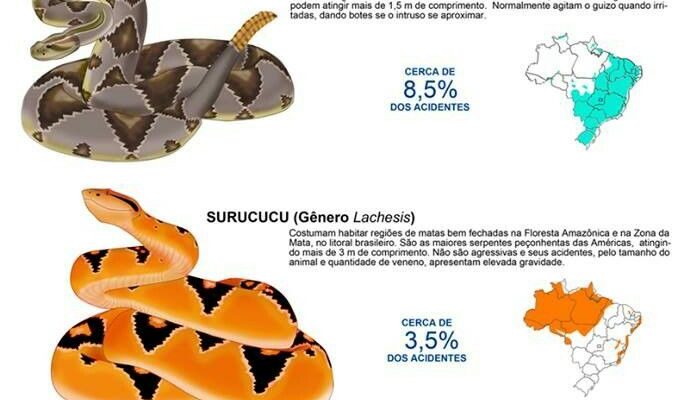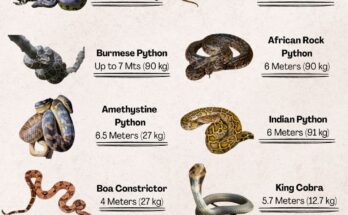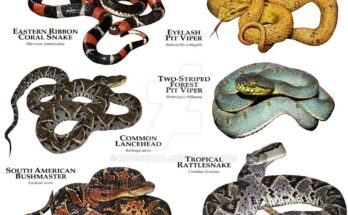Exploring the Venomous Snakes Responsible for Envenomations in Brazil
Brazil’s diverse ecosystems are home to a variety of venomous snakes, some of which pose significant health risks to humans. This detailed guide, based on the educational chart created by Marcus Buononato and featured by Ciência Brasil, highlights the four primary genera of snakes responsible for envenomations in the country: Jararaca, Cascavel, Surucucu, and Cobra-Coral. Each species is accompanied by its contribution to the total number of snakebite incidents, along with geographical distribution maps, providing a comprehensive overview for residents, travelers, and wildlife enthusiasts.

1. Jararaca (Genus Bothrops)
The Jararaca, belonging to the Bothrops genus, is the most common culprit behind snakebites in Brazil, accounting for approximately 87% of all incidents. These pit vipers are characterized by their robust bodies and distinctive geometric or triangular patterns, typically in shades of brown, yellow, and black. Adults generally measure between 60 cm and 1.5 meters in length. Jararacas are widespread across the entire country, as indicated by the green-shaded map covering all of Brazil. They are highly adaptable, thriving in forests, grasslands, and even near human settlements. Their venom is hemotoxic, causing severe tissue damage, swelling, and systemic bleeding. These snakes are particularly aggressive when molested, making caution essential in their habitats.
2. Cascavel (Genus Crotalus)
Cascavels, from the Crotalus genus, are the Brazilian rattlesnakes and contribute around 8.5% of snakebite incidents. Recognizable by the rattle at the end of their tail, these pit vipers feature a diamond-shaped pattern in shades of brown, tan, and gray. Adults typically grow to lengths of 1 to 1.5 meters. Their distribution is concentrated in the northeastern and central-western regions of Brazil, as shown by the blue-shaded areas on the map. Cascavels prefer arid and semi-arid environments, such as the Caatinga and Cerrado biomes. When threatened, they vibrate their rattles as a warning. Their venom combines neurotoxic and hemotoxic properties, leading to symptoms like respiratory distress and tissue necrosis, necessitating immediate medical attention.
3. Surucucu (Genus Lachesis)
The Surucucu, part of the Lachesis genus, accounts for about 3.5% of envenomations. Known as one of the largest venomous snakes in the Americas, these pit vipers can exceed 3 meters in length. They exhibit a striking pattern of brown, orange, and black with diamond or hourglass shapes, aiding their camouflage in the dense rainforests of the Amazon and Atlantic Forest regions, marked in orange on the map. Surucucus are formidable due to their potent hemotoxic venom, which causes extensive swelling, necrosis, and systemic effects. They are less frequently encountered due to their preference for remote forest habitats, but their large size and substantial venom yield make bites particularly dangerous.
4. Cobra-Coral (Genus Micrurus)
Cobra-Corals, from the Micrurus genus, are responsible for the smallest percentage of incidents, approximately 1%. These elapid snakes are easily identified by their vivid red, black, and yellow or white banded patterns, which serve as a warning of their highly neurotoxic venom. Adults typically measure between 70 cm and 1.5 meters. Their range spans the entire country, as depicted by the pink-shaded map. Cobra-Corals inhabit a variety of environments, including forests, savannas, and even urban areas. Their venom can cause paralysis and respiratory failure, and bites are considered extremely grave. The chart notes that these snakes are highly venomous, especially when handled, underscoring the need for caution.
Statistical Insights and Safety Considerations
The chart provides critical data on the prevalence of snakebites, with Jararacas leading at 87%, followed by Cascavels at 8.5%, Surucucus at 3.5%, and Cobra-Corals at 1%. This distribution reflects the snakes’ habitats and human interactions within those regions. The maps illustrate their widespread presence across Brazil, emphasizing the need for awareness nationwide. All four genera deliver potent venoms with varying effects—hemotoxic, neurotoxic, or a combination—making snakebites a public health concern. Immediate medical intervention, including antivenom administration, is vital to mitigate severe outcomes.
Educational and Safety Message
Created by Marcus Buononato and featured by Ciência Brasil, this resource serves as an essential educational tool. It highlights the importance of recognizing these snakes by their physical traits and understanding their geographical prevalence. The key takeaway is clear: avoid handling or approaching any snake, as even non-aggressive species can bite when threatened. For residents and visitors, learning to identify these species and seeking prompt medical help in case of a bite can be life-saving. This guide encourages respect for Brazil’s rich biodiversity while prioritizing human safety.
Image Credit: Marcus Buononato / Ciência Brasil
Date: July 12, 2025, 12:55 PM EDT



